Unit 6 When was it invented? SectionA 3a-3c 说课课件(共29张PPT)人教版英语九年级全册
文档属性
| 名称 | Unit 6 When was it invented? SectionA 3a-3c 说课课件(共29张PPT)人教版英语九年级全册 | 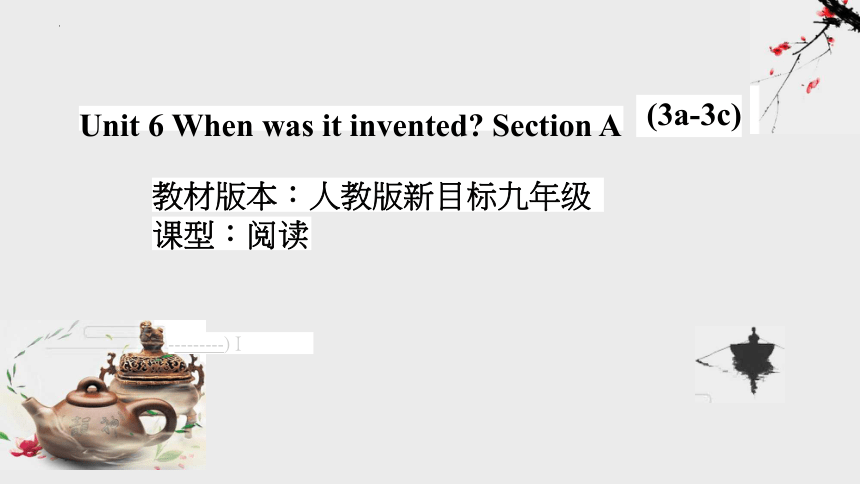 | |
| 格式 | pptx | ||
| 文件大小 | 1015.2KB | ||
| 资源类型 | 教案 | ||
| 版本资源 | 人教新目标(Go for it)版 | ||
| 科目 | 英语 | ||
| 更新时间 | 2023-07-06 21:15:06 | ||
图片预览

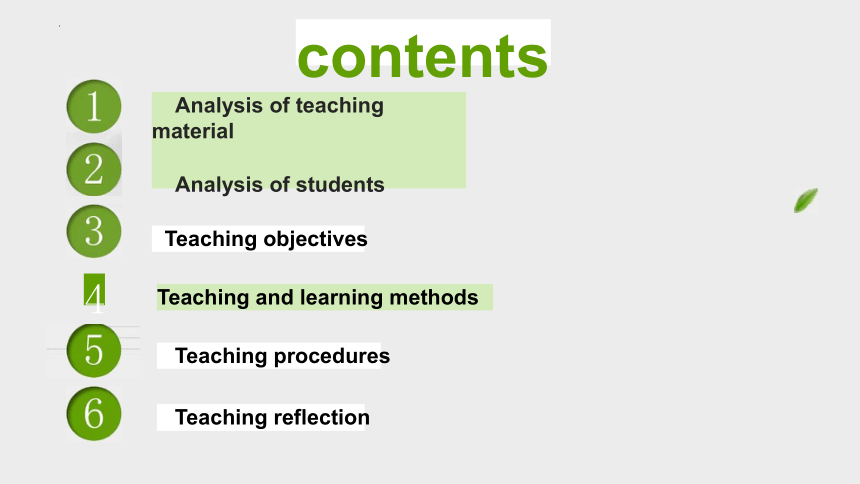
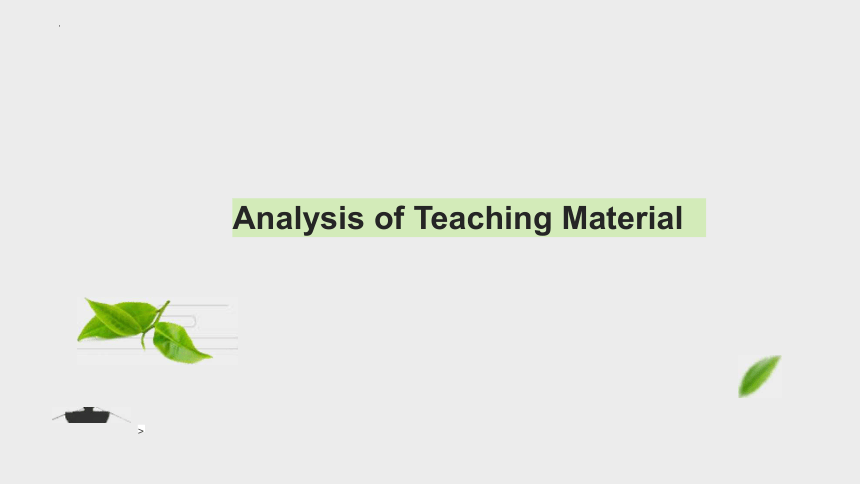
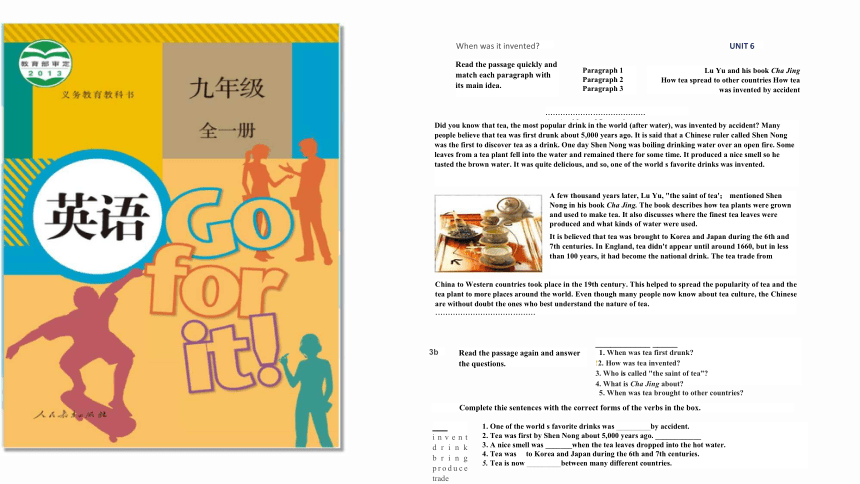
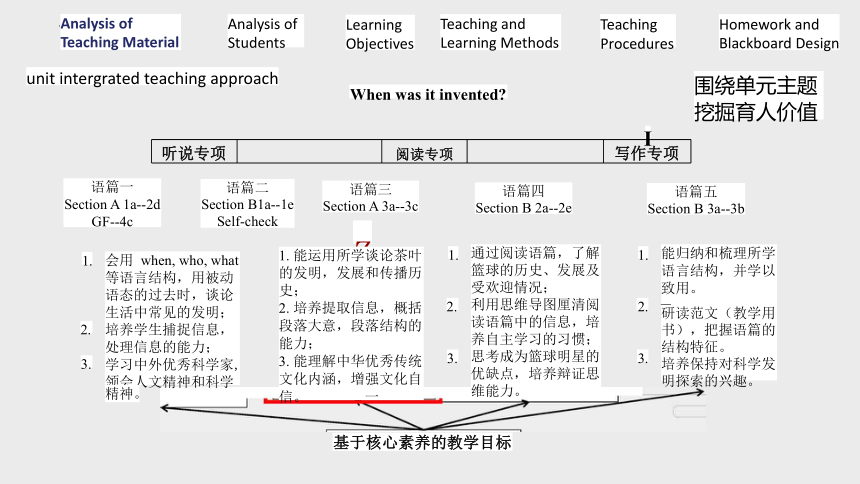
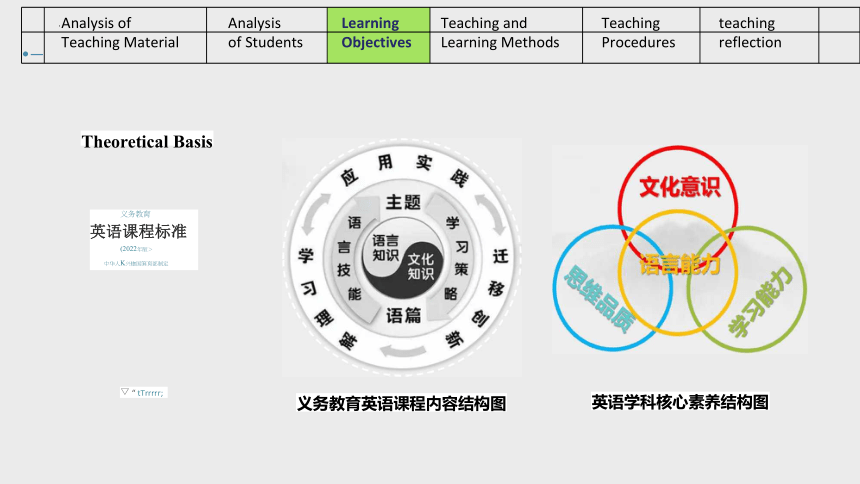
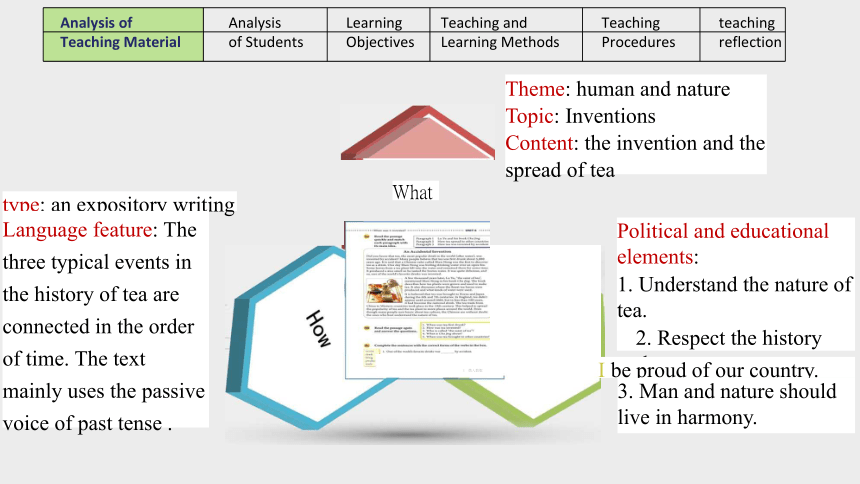
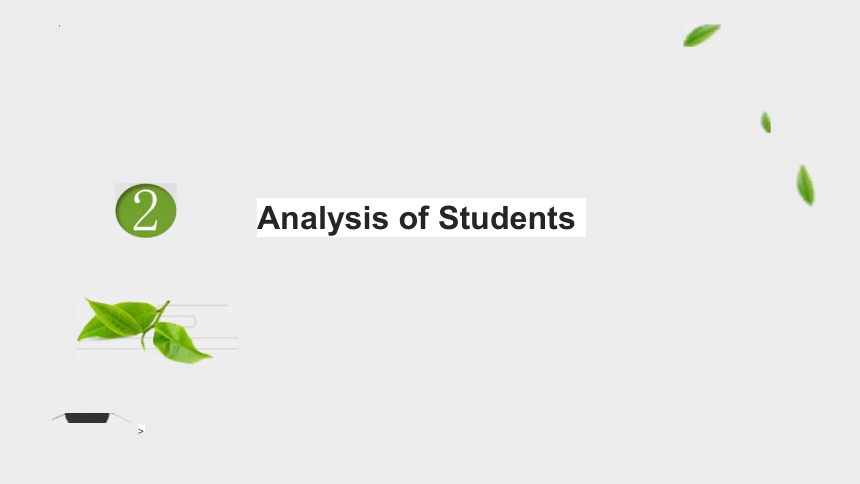
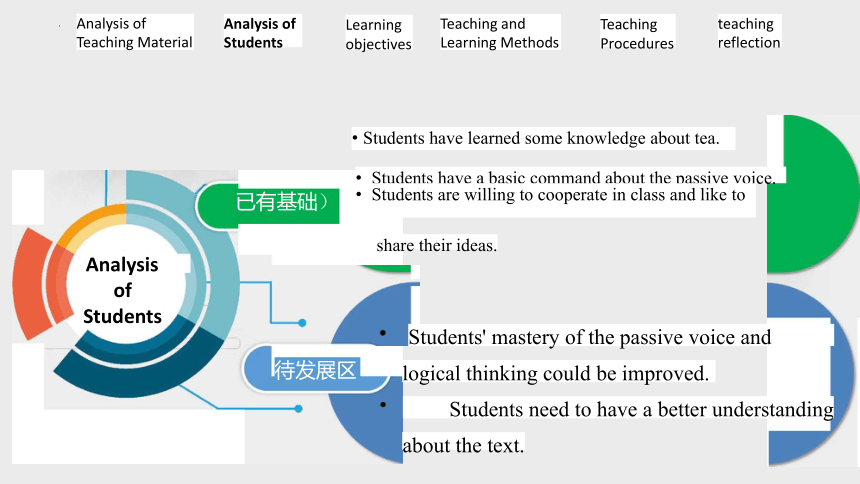
文档简介
(共29张PPT)
Unit 6 When was it invented Section A
(3a-3c)
教材版本:人教版新目标九年级
课型:阅读
---------) I
contents
Analysis of teaching material
Analysis of students
Teaching objectives
4
Teaching and learning methods
Teaching procedures
Teaching reflection
Analysis of Teaching Material
>
When was it invented
UNIT 6
Read the passage quickly and match each paragraph with its main idea.
Paragraph 1
Paragraph 2
Paragraph 3
Lu Yu and his book Cha Jing
How tea spread to other countries How tea was invented by accident
........................................
An Accidental Invention
Did you know that tea, the most popular drink in the world (after water), was invented by accident Many people believe that tea was first drunk about 5,000 years ago. It is said that a Chinese ruler called Shen Nong was the first to discover tea as a drink. One day Shen Nong was boiling drinking water over an open fire. Some leaves from a tea plant fell into the water and remained there for some time. It produced a nice smell so he tasted the brown water. It was quite delicious, and so, one of the world s favorite drinks was invented.
A few thousand years later, Lu Yu, "the saint of tea'; mentioned Shen Nong in his book Cha Jing. The book describes how tea plants were grown and used to make tea. It also discusses where the finest tea leaves were produced and what kinds of water were used.
It is believed that tea was brought to Korea and Japan during the 6th and 7th centuries. In England, tea didn't appear until around 1660, but in less than 100 years, it had become the national drink. The tea trade from
China to Western countries took place in the 19th century. This helped to spread the popularity of tea and the tea plant to more places around the world. Even though many people now know about tea culture, the Chinese are without doubt the ones who best understand the nature of tea.
........................................
3b
Read the passage again and answer the questions.
___________ _____
1. When was tea first drunk
!2. How was tea invented
3. Who is called "the saint of tea”
4. What is Cha Jing about
5. When was tea brought to other countries
Complete thie sentences with the correct forms of the verbs in the box.
___
invent drink bring produce trade
1. One of the world s favorite drinks was _________by accident.
2. Tea was first by Shen Nong about 5,000 years ago. ____________
3. A nice smell was _______when the tea leaves dropped into the hot water.
4. Tea was to Korea and Japan during the 6th and 7th centuries.
5. Tea is now _________between many different countries.
unit intergrated teaching approach
When was it invented
I
z
1.
1.
1.
2.
2.
2.
3.
3.
3.
基于核心素养的教学目标
围绕单元主题 挖掘育人价值
会用 when, who, what 等语言结构,用被动 语态的过去时,谈论 生活中常见的发明; 培养学生捕捉信息, 处理信息的能力; 学习中外优秀科学家, 领会人文精神和科学
精神。
1. 能运用所学谈论茶叶 的发明,发展和传播历 史;
2. 培养提取信息,概括 段落大意,段落结构的 能力;
3. 能理解中华优秀传统
文化内涵,增强文化自 信。 一
通过阅读语篇,了解 篮球的历史、发展及 受欢迎情况;
利用思维导图厘清阅 读语篇中的信息,培 养自主学习的习惯; 思考成为篮球明星的 优缺点,培养辩证思 维能力。
能归纳和梳理所学 语言结构,并学以 致用。
__
研读范文(教学用 书),把握语篇的 结构特征。
培养保持对科学发 明探索的兴趣。
Analysis of Teaching Material
Learning
Objectives
Teaching Procedures
Homework and
Blackboard Design
Analysis of Students
Teaching and Learning Methods
语篇二
Section B1a--1e
Self-check
语篇三
Section A 3a--3c
语篇一
Section A 1a--2d
GF--4c
语篇四
Section B 2a--2e
语篇五
Section B 3a--3b
听说专项 阅读专项 写作专项
Analysis of Analysis Learning Teaching and Teaching teaching
— Teaching Material of Students Objectives Learning Methods Procedures reflection
Theoretical Basis
义务教育
英语课程标准
(2022年版>
中华人K兴枷国箕育部制定
▽ “ tTrrrrr;
义务教育英语课程内容结构图
英语学科核心素养结构图
What
Theme: human and nature
Topic: Inventions
Content: the invention and the spread of tea
type: an expository writing
Language feature: The three typical events in the history of tea are connected in the order of time. The text mainly uses the passive voice of past tense .
E 勇入敎版
Political and educational elements:
1. Understand the nature of tea.
2. Respect the history and
I be proud of our country.
3. Man and nature should live in harmony.
Analysis of Analysis Learning Teaching and Teaching teaching
Teaching Material of Students Objectives Learning Methods Procedures reflection
Analysis of Students
>
Analysis of Teaching Material
Analysis of Students
Learning objectives
Teaching and Learning Methods
Teaching Procedures
teaching reflection
share their ideas.
Students' mastery of the passive voice and
logical thinking could be improved.
about the text.
已有基础)
待发展区
Students need to have a better understanding
Students have a basic command about the passive voice.
Students are willing to cooperate in class and like to
Students have learned some knowledge about tea.
Analysis
of
Students
3」
Learning objectives
V A
Analysis of Analysis Learning Teaching and Teaching teaching
Teaching Material of Students Objectives Learning Methods Procedures reflection
By the end of the class, the students will be able to : __
, 学习理解
1. use the key words in the real context: accidental, by accident, ruler, boil, remain, smell, trade, without doubt.
,学习理解+应用实践
2. leam the tea culture by telling the story and the history of tea
using the pictures and the timeline for help. /
■应用实践+迁移创新
3. cultivate students5 sense of national confidence and pride
4
Teaching and Learning Methods
V A
methods
teaching reflection
Analysis of Teaching Material
02
03
question teachin method ■
Individual study
01
Situational language teaching method
04
Cooperative study
Analysis Learning Teaching and Teaching
of Students Objectives Learning Methods Procedures
5j
Teaching Procedures
V A
Analysis of
Teaching Material
Analysis of Students
Learning
Objectives
Teaching and Learning Methods
Teaching Procedures
teaching reflection
Lead in
prereading
group discussion create a situation
levels of homework
(2 mins)
reading activities (30mins)
whilereading
postreading
Homework
prediction (1 min)
further understanding
(5 mins)
Analysis of Analysis
Teaching Material of Students
lead in and warm up 丿
I. group discussion
I. create a situation
purpose
promote students to learn from each other and use the language in the real context
Learning Teaching and
Objectives Learning Methods
Teaching Procedures
teaching reflection
There is a fbrum(论坛)about the Belt and Road(一带一路).Now you are the representative(代表)of our school to be a spreader about our tea culture.
To be a tea
spreader .
Let's get more information about tea!
Chinese Tea Ancestral Culture Park
nvention
get to know
passage and the picture
lu. k afeo when tbc fiant la team am 5mi bait ofwm 3.
kiabckm^tiuilQ vastvMfkttoKMraaftdJfM
IvWnaeHKOTalnntMk^horathr l^tbcatHy lb k^ed i ipfud odjaty WiuMddMieivUatiPBorcriKHwoMdtWiMadLi Ewa
z dmk om 如 ftta Neaj w ItMfaf dnabaf w*f m ■ o^c* — smbt ImnfroaiJiNfUrt WModbr MnMdfm*aelchml rMMMc k podaod a a ■! m> ht uattd tW beon v*cr ayvijr. h m『te boeaa ■ dtt vsjl er V ■ wdii (nor* 4nnb ■ umattii
lwfeflM4SUiNMfiBhiU^Ch>y.1fekol
I . ■农心 A g 叶■心 3 3 auU
Accidcnu! Invention I
>. W11CT}.
get to know the main idea of the passage through the title and the picture
__________ 学习理解
Predict from the picture and the title.
1. What invention does the passage talk about
The passage talks about tea.
2. Tea was invented by accident
Analysis of Analysis
Teaching Material of Students
Teaching Teaching and
Objectives Learning Methods
Teaching teaching
Procedures reflection
Teaching Procedures
Analysis of Students
Teaching and Learning Methods
Analysis of
Teaching Material
Learning
Objectives
teaching reflection
I while reading
Activity 1 Read and match
Individual work and pair check)
purpose
1. to train students to grasp the main ideas
2. tip: The topic sentence usually appears at the beginning of each paragraph.
It is believed that tea was brought to Korea aad Japan duiing the 6th 卫nd 7th centuries, In England, tea didn't appear until around 1660, but in less than 100 years, it had become the national drink.The tea trade from China to Western countries took place in the 19th century.This helped to spread the popularity of tea and the tea plant to more places around the world. Even though many people now know about tea culture, the Chinese are without doubt the ones who best understand the nature of tea.
学习理解+应用实践
How tea was invented by accident
ch paragraph with its main idea.
itries
Lu Yu and his book Cha Jing
water.lt wa
invented.
How tea spread to other countries
How tea was invented by accident
over an op remained th
I A few thousand years later, Lu Yu, "the saint of tea", mentioned Shen Nong in his book Cha Jing. The book describes how tea plants were grown and used to make tea. It also discusses where the finest tea leaves were produced and what kinds of water were used.
Did you know that tea,the most popular drink in the world (after water), was invented by accident Many people believe that tea was first drunk about 5,000 years to discover
Analysis of
Teaching Material
Analysis of Students
Learning Teaching and
Objectives Learning Methods
Teaching Procedures
teaching reflection
I Activity 2 read and find out (Individual work and group check)
careful reading
purpose
search for a clue to the connection between the two persons in the text to develop students' logical thinking
学习理解+应用实践
Analysis of
Teaching Material
Analysis of Students
Learning Teaching and
Objectives Learning Methods
Teaching Procedures
teaching reflection
(I j/yhilesreadinq
学习理解+应用实践
Activity 3 tell the story (class activity and personal presentation)
a tea plant
fell into remained produced tasted
boiling water
over an open fire
leavesfrom
_ A Chinese ~ ruler
Shen Nong
The activity is about the training for
visualization of thinking.
'the' story
Vrf粗8州
A Chinese ~~7 Shen Nong
—__W “is/**,
me s , / 、Sr
〃仆 et/ / .
<站j
& S, , % 十
%,
popular
centuries
5—MQyj
Unr i 瓶 8n\mu "
tea trade from China to Western countries
19th century
About years
Ground 1660
Welcome to bcautifiil China...
Analysis of
Teaching Material
Analysis of Students
Learning
Objectives
Teaching and
Learning Methods
teaching
reflection
I Activity 4
( 学习理解+应用实践
Welcome to beautiful China ...
appeared in England
was first drunk
one of the world's favorite drinks
was brought to Korea and Japan
Cha Jing was written by Lu Yu ind
■貯刁had
become
I popular
Help students to use the language in the real context.
Shen Nong invented by accident
purpose
|To be a tea spreader for the Silk Road Program I pairwork and personal presentation)
C/u/ G StcUtm. Z( || A /I
Teaching Procedures
I post reading
What is the nature of tea
purpose
teaching
reflection
应用实践+迁移创新
I Watch and think(group discussion)
___■
1. develop more advanced way of
thinking habits
2. The spirits of Chinese set good examples for us, which can cultivate the students' positive emotions
Analysis of Analysis Learning Teaching and Teaching
Teaching Material of Students Objectives Learning Methods Procedures
Analysis of Analysis Learning Teaching and Teaching teaching
Teaching Material of Students Objectives Learning Methods Procedures reflection
evaluation chart
评价环节 评价细则 等级 自评 互评
课前自学 按要求完成前置性任务卡中相关内容。 A B C
对学环节 与同伴一起学习记忆任务卡中的重点词汇表达。 积极与同伴分享搜集的有关中国茶艺信息并倾听同伴发言。 A B C
阅读环节 能准确流畅的朗读本节课的语篇。 运用本节课语言结构简述中国茶文化的发明、发展和传播。 能表达自己对中国茶文化的观点。 A B C
群学环节 积极参与小组合作学习,并能出色完成小组分工任务。 A B C
当堂检测 能独立且准确完成课堂检测内容。 A B C
Analysis of
Teaching Material
Analysis of Students
Learning
Objectives
Teaching and Learning Methods
Teaching Procedures
teaching
reflection
1. Read 3a fluntly.
2. Finish 3c.
3. Draw a mind map about the passage.
Homework
To be a better tea spreader Make a video to introduce tea culture (search more information)
tJe hietjonej Slieh
jnventedjt
vvere
应)to maS也
Pice 河
indiel^cehi
Accidental Ihvention
l^^ereprodLicedl _
B、Some 奶 fea 經! 也I into 血 wote^
Analysis of Students
Analysis of
Teaching Material
Learning
Objectives
Teaching Procedures
Teaching and Learning Methods
teaching
reflection
when.沖 go。博 ogo
4 ...、z
■ A L …丄 好 All/1 CCC
、
Wlbsa 施嗣r g
,otter
1
a 耐 ID) 魂p
invention
Unit 6 Section A An accidental invention
I Where was it invented I
q Whalstlieiiivenfo
When was it invented
cenhirv
during the 6th
aud 7tli
centuries
iu the 19th
around
in less than
6J
Teaching reflection
>
Analysis of
Teaching Material
Analysis of Students
Learning
Objectives
1. Try to get more students involved in activities.
2. Encourage students to design their own questions based on the text.
3....
highlights
Teaching reflection
Teaching and Teaching teaching
Learning Methods Procedures reflection
1. Create real contexts for students to practice the target language and cultivate advanced thinking.
2. Identify the grammar structure in the text instead of just remembering grammar rules automatically.
improvements
Unit 6 When was it invented Section A
(3a-3c)
教材版本:人教版新目标九年级
课型:阅读
---------) I
contents
Analysis of teaching material
Analysis of students
Teaching objectives
4
Teaching and learning methods
Teaching procedures
Teaching reflection
Analysis of Teaching Material
>
When was it invented
UNIT 6
Read the passage quickly and match each paragraph with its main idea.
Paragraph 1
Paragraph 2
Paragraph 3
Lu Yu and his book Cha Jing
How tea spread to other countries How tea was invented by accident
........................................
An Accidental Invention
Did you know that tea, the most popular drink in the world (after water), was invented by accident Many people believe that tea was first drunk about 5,000 years ago. It is said that a Chinese ruler called Shen Nong was the first to discover tea as a drink. One day Shen Nong was boiling drinking water over an open fire. Some leaves from a tea plant fell into the water and remained there for some time. It produced a nice smell so he tasted the brown water. It was quite delicious, and so, one of the world s favorite drinks was invented.
A few thousand years later, Lu Yu, "the saint of tea'; mentioned Shen Nong in his book Cha Jing. The book describes how tea plants were grown and used to make tea. It also discusses where the finest tea leaves were produced and what kinds of water were used.
It is believed that tea was brought to Korea and Japan during the 6th and 7th centuries. In England, tea didn't appear until around 1660, but in less than 100 years, it had become the national drink. The tea trade from
China to Western countries took place in the 19th century. This helped to spread the popularity of tea and the tea plant to more places around the world. Even though many people now know about tea culture, the Chinese are without doubt the ones who best understand the nature of tea.
........................................
3b
Read the passage again and answer the questions.
___________ _____
1. When was tea first drunk
!2. How was tea invented
3. Who is called "the saint of tea”
4. What is Cha Jing about
5. When was tea brought to other countries
Complete thie sentences with the correct forms of the verbs in the box.
___
invent drink bring produce trade
1. One of the world s favorite drinks was _________by accident.
2. Tea was first by Shen Nong about 5,000 years ago. ____________
3. A nice smell was _______when the tea leaves dropped into the hot water.
4. Tea was to Korea and Japan during the 6th and 7th centuries.
5. Tea is now _________between many different countries.
unit intergrated teaching approach
When was it invented
I
z
1.
1.
1.
2.
2.
2.
3.
3.
3.
基于核心素养的教学目标
围绕单元主题 挖掘育人价值
会用 when, who, what 等语言结构,用被动 语态的过去时,谈论 生活中常见的发明; 培养学生捕捉信息, 处理信息的能力; 学习中外优秀科学家, 领会人文精神和科学
精神。
1. 能运用所学谈论茶叶 的发明,发展和传播历 史;
2. 培养提取信息,概括 段落大意,段落结构的 能力;
3. 能理解中华优秀传统
文化内涵,增强文化自 信。 一
通过阅读语篇,了解 篮球的历史、发展及 受欢迎情况;
利用思维导图厘清阅 读语篇中的信息,培 养自主学习的习惯; 思考成为篮球明星的 优缺点,培养辩证思 维能力。
能归纳和梳理所学 语言结构,并学以 致用。
__
研读范文(教学用 书),把握语篇的 结构特征。
培养保持对科学发 明探索的兴趣。
Analysis of Teaching Material
Learning
Objectives
Teaching Procedures
Homework and
Blackboard Design
Analysis of Students
Teaching and Learning Methods
语篇二
Section B1a--1e
Self-check
语篇三
Section A 3a--3c
语篇一
Section A 1a--2d
GF--4c
语篇四
Section B 2a--2e
语篇五
Section B 3a--3b
听说专项 阅读专项 写作专项
Analysis of Analysis Learning Teaching and Teaching teaching
— Teaching Material of Students Objectives Learning Methods Procedures reflection
Theoretical Basis
义务教育
英语课程标准
(2022年版>
中华人K兴枷国箕育部制定
▽ “ tTrrrrr;
义务教育英语课程内容结构图
英语学科核心素养结构图
What
Theme: human and nature
Topic: Inventions
Content: the invention and the spread of tea
type: an expository writing
Language feature: The three typical events in the history of tea are connected in the order of time. The text mainly uses the passive voice of past tense .
E 勇入敎版
Political and educational elements:
1. Understand the nature of tea.
2. Respect the history and
I be proud of our country.
3. Man and nature should live in harmony.
Analysis of Analysis Learning Teaching and Teaching teaching
Teaching Material of Students Objectives Learning Methods Procedures reflection
Analysis of Students
>
Analysis of Teaching Material
Analysis of Students
Learning objectives
Teaching and Learning Methods
Teaching Procedures
teaching reflection
share their ideas.
Students' mastery of the passive voice and
logical thinking could be improved.
about the text.
已有基础)
待发展区
Students need to have a better understanding
Students have a basic command about the passive voice.
Students are willing to cooperate in class and like to
Students have learned some knowledge about tea.
Analysis
of
Students
3」
Learning objectives
V A
Analysis of Analysis Learning Teaching and Teaching teaching
Teaching Material of Students Objectives Learning Methods Procedures reflection
By the end of the class, the students will be able to : __
, 学习理解
1. use the key words in the real context: accidental, by accident, ruler, boil, remain, smell, trade, without doubt.
,学习理解+应用实践
2. leam the tea culture by telling the story and the history of tea
using the pictures and the timeline for help. /
■应用实践+迁移创新
3. cultivate students5 sense of national confidence and pride
4
Teaching and Learning Methods
V A
methods
teaching reflection
Analysis of Teaching Material
02
03
question teachin method ■
Individual study
01
Situational language teaching method
04
Cooperative study
Analysis Learning Teaching and Teaching
of Students Objectives Learning Methods Procedures
5j
Teaching Procedures
V A
Analysis of
Teaching Material
Analysis of Students
Learning
Objectives
Teaching and Learning Methods
Teaching Procedures
teaching reflection
Lead in
prereading
group discussion create a situation
levels of homework
(2 mins)
reading activities (30mins)
whilereading
postreading
Homework
prediction (1 min)
further understanding
(5 mins)
Analysis of Analysis
Teaching Material of Students
lead in and warm up 丿
I. group discussion
I. create a situation
purpose
promote students to learn from each other and use the language in the real context
Learning Teaching and
Objectives Learning Methods
Teaching Procedures
teaching reflection
There is a fbrum(论坛)about the Belt and Road(一带一路).Now you are the representative(代表)of our school to be a spreader about our tea culture.
To be a tea
spreader .
Let's get more information about tea!
Chinese Tea Ancestral Culture Park
nvention
get to know
passage and the picture
lu. k afeo when tbc fiant la team am 5mi bait ofwm 3.
kiabckm^tiuilQ vastvMfkttoKMraaftdJfM
IvWnaeHKOTalnntMk^horathr l^tbcatHy lb k^ed i ipfud odjaty WiuMddMieivUatiPBorcriKHwoMdtWiMadLi Ewa
z dmk om 如 ftta Neaj w ItMfaf dnabaf w*f m ■ o^c* — smbt ImnfroaiJiNfUrt WModbr MnMdfm*aelchml rMMMc k podaod a a ■! m> ht uattd tW beon v*cr ayvijr. h m『te boeaa ■ dtt vsjl er V ■ wdii (nor* 4nnb ■ umattii
lwfeflM4SUiNMfiBhiU^Ch>y.1fekol
I . ■农心 A g 叶■心 3 3 auU
Accidcnu! Invention I
>. W11CT}.
get to know the main idea of the passage through the title and the picture
__________ 学习理解
Predict from the picture and the title.
1. What invention does the passage talk about
The passage talks about tea.
2. Tea was invented by accident
Analysis of Analysis
Teaching Material of Students
Teaching Teaching and
Objectives Learning Methods
Teaching teaching
Procedures reflection
Teaching Procedures
Analysis of Students
Teaching and Learning Methods
Analysis of
Teaching Material
Learning
Objectives
teaching reflection
I while reading
Activity 1 Read and match
Individual work and pair check)
purpose
1. to train students to grasp the main ideas
2. tip: The topic sentence usually appears at the beginning of each paragraph.
It is believed that tea was brought to Korea aad Japan duiing the 6th 卫nd 7th centuries, In England, tea didn't appear until around 1660, but in less than 100 years, it had become the national drink.The tea trade from China to Western countries took place in the 19th century.This helped to spread the popularity of tea and the tea plant to more places around the world. Even though many people now know about tea culture, the Chinese are without doubt the ones who best understand the nature of tea.
学习理解+应用实践
How tea was invented by accident
ch paragraph with its main idea.
itries
Lu Yu and his book Cha Jing
water.lt wa
invented.
How tea spread to other countries
How tea was invented by accident
over an op remained th
I A few thousand years later, Lu Yu, "the saint of tea", mentioned Shen Nong in his book Cha Jing. The book describes how tea plants were grown and used to make tea. It also discusses where the finest tea leaves were produced and what kinds of water were used.
Did you know that tea,the most popular drink in the world (after water), was invented by accident Many people believe that tea was first drunk about 5,000 years to discover
Analysis of
Teaching Material
Analysis of Students
Learning Teaching and
Objectives Learning Methods
Teaching Procedures
teaching reflection
I Activity 2 read and find out (Individual work and group check)
careful reading
purpose
search for a clue to the connection between the two persons in the text to develop students' logical thinking
学习理解+应用实践
Analysis of
Teaching Material
Analysis of Students
Learning Teaching and
Objectives Learning Methods
Teaching Procedures
teaching reflection
(I j/yhilesreadinq
学习理解+应用实践
Activity 3 tell the story (class activity and personal presentation)
a tea plant
fell into remained produced tasted
boiling water
over an open fire
leavesfrom
_ A Chinese ~ ruler
Shen Nong
The activity is about the training for
visualization of thinking.
'the' story
Vrf粗8州
A Chinese ~~7 Shen Nong
—__W “is/**,
me s , / 、Sr
〃仆 et/ / .
<站j
& S, , % 十
%,
popular
centuries
5—MQyj
Unr i 瓶 8n\mu "
tea trade from China to Western countries
19th century
About years
Ground 1660
Welcome to bcautifiil China...
Analysis of
Teaching Material
Analysis of Students
Learning
Objectives
Teaching and
Learning Methods
teaching
reflection
I Activity 4
( 学习理解+应用实践
Welcome to beautiful China ...
appeared in England
was first drunk
one of the world's favorite drinks
was brought to Korea and Japan
Cha Jing was written by Lu Yu ind
■貯刁had
become
I popular
Help students to use the language in the real context.
Shen Nong invented by accident
purpose
|To be a tea spreader for the Silk Road Program I pairwork and personal presentation)
C/u/ G StcUtm. Z( || A /I
Teaching Procedures
I post reading
What is the nature of tea
purpose
teaching
reflection
应用实践+迁移创新
I Watch and think(group discussion)
___■
1. develop more advanced way of
thinking habits
2. The spirits of Chinese set good examples for us, which can cultivate the students' positive emotions
Analysis of Analysis Learning Teaching and Teaching
Teaching Material of Students Objectives Learning Methods Procedures
Analysis of Analysis Learning Teaching and Teaching teaching
Teaching Material of Students Objectives Learning Methods Procedures reflection
evaluation chart
评价环节 评价细则 等级 自评 互评
课前自学 按要求完成前置性任务卡中相关内容。 A B C
对学环节 与同伴一起学习记忆任务卡中的重点词汇表达。 积极与同伴分享搜集的有关中国茶艺信息并倾听同伴发言。 A B C
阅读环节 能准确流畅的朗读本节课的语篇。 运用本节课语言结构简述中国茶文化的发明、发展和传播。 能表达自己对中国茶文化的观点。 A B C
群学环节 积极参与小组合作学习,并能出色完成小组分工任务。 A B C
当堂检测 能独立且准确完成课堂检测内容。 A B C
Analysis of
Teaching Material
Analysis of Students
Learning
Objectives
Teaching and Learning Methods
Teaching Procedures
teaching
reflection
1. Read 3a fluntly.
2. Finish 3c.
3. Draw a mind map about the passage.
Homework
To be a better tea spreader Make a video to introduce tea culture (search more information)
tJe hietjonej Slieh
jnventedjt
vvere
应)to maS也
Pice 河
indiel^cehi
Accidental Ihvention
l^^ereprodLicedl _
B、Some 奶 fea 經! 也I into 血 wote^
Analysis of Students
Analysis of
Teaching Material
Learning
Objectives
Teaching Procedures
Teaching and Learning Methods
teaching
reflection
when.沖 go。博 ogo
4 ...、z
■ A L …丄 好 All/1 CCC
、
Wlbsa 施嗣r g
,otter
1
a 耐 ID) 魂p
invention
Unit 6 Section A An accidental invention
I Where was it invented I
q Whalstlieiiivenfo
When was it invented
cenhirv
during the 6th
aud 7tli
centuries
iu the 19th
around
in less than
6J
Teaching reflection
>
Analysis of
Teaching Material
Analysis of Students
Learning
Objectives
1. Try to get more students involved in activities.
2. Encourage students to design their own questions based on the text.
3....
highlights
Teaching reflection
Teaching and Teaching teaching
Learning Methods Procedures reflection
1. Create real contexts for students to practice the target language and cultivate advanced thinking.
2. Identify the grammar structure in the text instead of just remembering grammar rules automatically.
improvements
同课章节目录
- Unit 1 How can we become good learners.
- Section A
- Section B
- Unit 2 I think that mooncakes are delicious!
- Section A
- Section B
- Unit 3 Could you please tell me where the restroom
- Section A
- Section B
- Unit 4 I used to be afraid of the dark.
- Section A
- Section B
- Unit 5 What are the shirts made of?
- Section A
- Section B
- Review of Units 1-5
- Unit 6 When was it invented?
- Section A
- Section B
- Unit 7 Teenagers should be allowed to choose their
- Section A
- Section B
- Unit 8 It must belong to Carla.
- Section A
- Section B
- Unit 9 I like music that I can dance to.
- Section A
- Section B
- Unit 10 You're supposed to shake hands.
- Section A
- Section B
- Review of Units 6-10
- Unit 11 Sad movies make me cry.
- Section A
- Section B
- Unit 12 Life is full of the unexpected
- Section A
- Section B
- Unit 13 We're trying to save the earth!
- Section A
- Section B
- Unit 14 I remember meeting all of you in Grade 7.
- Section A
- Section B
- Review of Units 11-14
